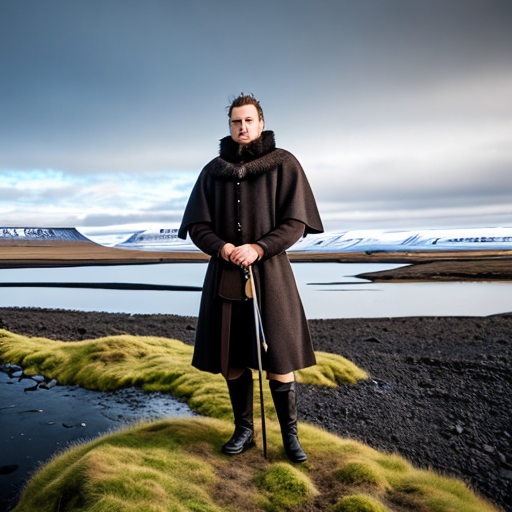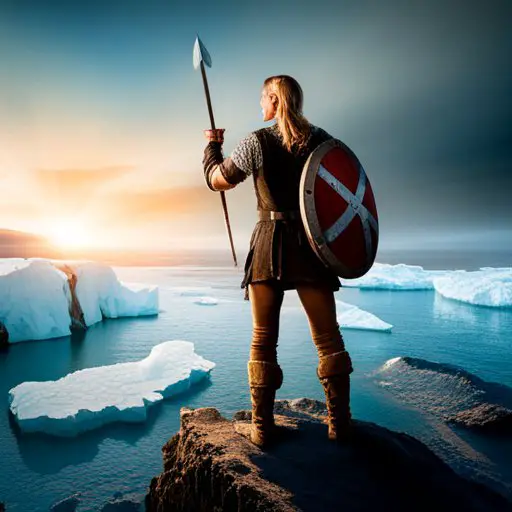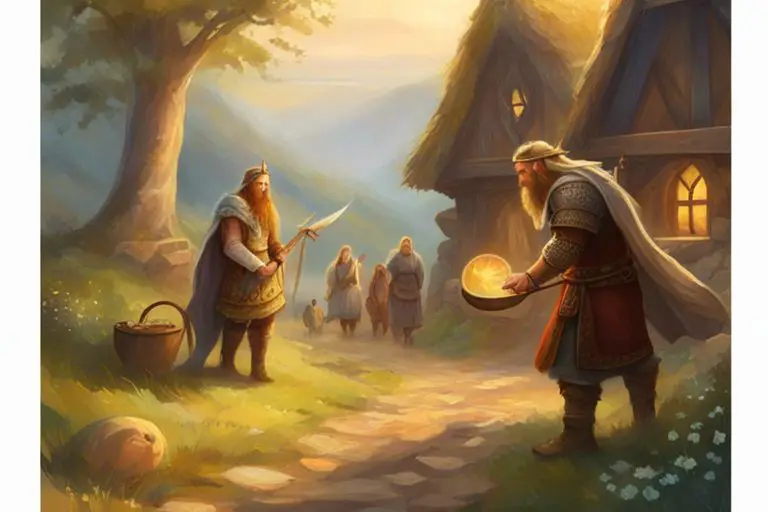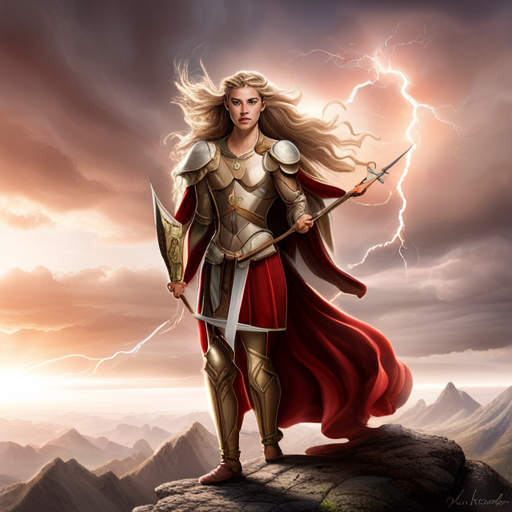As a lover of literature and history, I have always been fascinated by the Icelandic Sagas. These ancient texts are a treasure trove of stories that transport us back in time to the world of Vikings and Norse mythology.
But what makes the Icelandic Sagas truly special is the way they depict heroes and heroines in a way that resonates with us even today.
In this article, I want to explore the role of heroes and heroines in Old Norse literature, and how the Icelandic Sagas shaped our understanding of these archetypes.
From the legendary exploits of figures like Ragnar Lothbrok and Grettir the Strong to the complex and nuanced portrayals of women like Gudrun and Helga, the Icelandic Sagas offer a rich tapestry of characters that continue to captivate us to this day.
So, come with me on a journey through the world of the Icelandic Sagas, and discover the heroes and heroines who still speak to us across the centuries.
The Origins of the Icelandic Sagas
So you’re wondering about where these epic tales of adventure and intrigue come from, eh? Well, let me tell you about the origins of these ancient stories that have captivated readers for centuries.
The Icelandic Sagas, also known as the Family Sagas, are a collection of narratives that were written in Old Norse during the 13th and 14th centuries. These tales were created by anonymous authors who drew inspiration from the oral traditions of their ancestors.
Many of these sagas were written in Iceland, a country that was founded by Viking settlers in the 9th century. These settlers brought with them their own customs, beliefs, and stories, which they passed down through generations of storytelling.
The Icelandic Sagas were a way for these people to preserve their history and culture, while also entertaining and educating future generations. These tales continue to be studied and enjoyed today, as they provide a unique glimpse into the lives of the people who lived during the Viking Age.
And that’s not all, the Icelandic Sagas are also known for their portrayal of heroes and heroines. In fact, the role of heroes in old Norse culture is a major theme that runs throughout these stories.
So, let’s dive deeper into the world of these ancient heroes and see what we can learn from them.
The Role of Heroes in Old Norse Culture
You’ll find that the section you’re reading presents an insightful analysis of the significance of legendary figures in the cultural context of ancient Scandinavia.
In old Norse culture, heroes were highly respected and were believed to have been chosen by the gods to carry out important tasks. They were seen as brave, strong, and fearless warriors who were willing to put their lives on the line for the sake of their people.
In the Icelandic sagas, heroes were often depicted as being larger than life, possessing extraordinary abilities, and being able to overcome great obstacles. They were also known for their loyalty, honor, and sense of duty.
It was believed that heroes in old Norse culture had a special relationship with the gods and that they were protected by them. This made them even more revered by their fellow countrymen, who looked up to them as role models and sources of inspiration.
As we move on to the next section about ‘the impact of heroines in old Norse literature,’ we will see that women also played an important role in the culture of ancient Scandinavia, and that their contributions were just as significant as those of their male counterparts.
The Impact of Heroines in Old Norse Literature
The role of women in ancient Scandinavia was equally important to that of men, and their impact on the culture and literature of the time cannot be overlooked.
In Old Norse literature, women played a significant role as heroines who were strong, independent, and brave. They were not just passive characters, but active participants in the events of the story.
One of the most famous heroines in Old Norse literature is Gudrun, who appears in several sagas. She is portrayed as a woman who is not afraid to speak her mind and stand up for herself. Gudrun is also a skilled poet and uses her words to express her feelings and opinions. Her story is full of tragedy, but she always manages to come out on top. Her strength and resilience have made her an inspiration for generations of women.
As we delve into the themes and motifs in the Icelandic sagas, we can see how these heroines fit into the larger narrative of Norse mythology. Their stories reveal the complex relationships between gods, humans, and the natural world. They also explore themes of love, revenge, and loyalty.
Through these sagas, we get a glimpse into the values and beliefs of ancient Scandinavia, as well as the important role that women played in shaping their society.
Themes and Motifs in the Icelandic Sagas
Get ready to explore the intricate relationships between gods, humans, and the natural world, as well as themes of love, revenge, and loyalty in these captivating stories. The Icelandic Sagas are filled with vivid imagery and tense conflicts that keep readers on the edge of their seats.
These stories were not only a way of preserving history and cultural traditions, but also a way of entertaining and inspiring audiences. One of the most prevalent themes in the Icelandic Sagas is the idea of fate and destiny. Characters often face difficult decisions and must navigate treacherous situations, but ultimately their choices are shaped by the will of the gods.
Another important motif is the concept of honor and reputation. Characters strive to uphold their family name and gain respect from their peers, even if it means sacrificing their own happiness. These themes and motifs make the Icelandic Sagas not only entertaining, but also thought-provoking and insightful into the values of the Norse culture.
As we delve deeper into the world of the Icelandic Sagas, we can’t help but be drawn to the memorable characters that populate these stories. From fierce warriors to cunning women, each character has a unique personality and backstory that adds depth to the narrative. We’ll explore the heroes and heroines that captivate readers and examine their motivations and actions.
So, buckle up and get ready to embark on a journey through the world of Old Norse literature.

Memorable Characters in the Icelandic Sagas
Step into the shoes of the captivating characters that breathe life into the pages of these timeless tales, each one a unique puzzle piece that adds depth and intrigue to the narrative.
From the fierce and fearless warrior, Egil Skallagrimsson, to the cunning and unpredictable heroine, Gudrun Osvifsdottir, the Icelandic sagas boast a plethora of unforgettable characters that have stood the test of time.
These characters are not only memorable because of their heroic deeds, but also because of their complex personalities and relatable struggles.
For instance, Gudrun Osvifsdottir, also known as the ‘Gudrun of the Laxdaela Saga,’ is a prime example of a multi-dimensional character. She is a woman who defies the traditional gender roles of her time by being independent, intelligent, and assertive.
However, she is also a character who experiences great loss and pain, which makes her relatable and human. Her story is a testament to the fact that even in a world dominated by men, women can be just as strong and capable of shaping their own destiny.
The Icelandic sagas are filled with characters like Gudrun, who challenge our perceptions and inspire us to be the heroes and heroines of our own lives.
Frequently Asked Questions
What impact did the Icelandic sagas have on modern literature?
As a literature enthusiast, it’s fascinating to see how the Icelandic Sagas have influenced modern literature. These ancient stories have inspired countless authors to create their own versions of tales of heroes and heroines.
From J.R.R. Tolkien’s Lord of the Rings to George R.R. Martin’s Game of Thrones, the influence of the Sagas can be seen in both the themes and characters. The Sagas are known for their realistic portrayals of human nature, and their focus on complex characters with flaws and virtues.
These elements are still relevant in modern literature, and it’s clear that the Sagas have left a lasting impact on the literary world.
How did the Icelandic sagas influence the political landscape of Iceland?
To be honest, I didn’t realize just how much the Icelandic Sagas impacted the political landscape of Iceland.
It turns out that these tales of heroism and adventure were not only entertaining, but they also served as a source of legal precedent and political legitimacy. The Icelandic people saw themselves as descendants of the great heroes and heroines of the Sagas, and this connection gave them a sense of pride and identity.
Additionally, the Sagas provided examples of how disputes could be resolved through mediation and negotiation rather than violence. This emphasis on peaceful resolution helped to shape Iceland’s political culture and contributed to its reputation as a peaceful and stable society.
What role did religion play in the development of the Icelandic sagas?
Religion played a significant role in the development of the Icelandic Sagas. It was a way for the people to connect with their gods and goddesses, and to seek guidance and protection from them.
The gods were often portrayed as powerful and wise, and their influence could be seen throughout the Sagas. Symbols such as Thor’s hammer, Yggdrasil, and the Valkyries added a unique rhythm and flow to the Sagas.
These symbols were not just representations of the gods; they were also a way for the people to connect with their own identity and sense of belonging. As a reader, I find it fascinating how religion was not just a part of the Sagas, but a driving force behind them.
It adds a layer of depth and complexity to the stories and characters, and reminds us that our beliefs and values shape who we are as individuals and as a community.
Are there any controversies or debates surrounding the authenticity of the Icelandic sagas?
So, let’s talk about the authenticity of the Icelandic sagas. There’s actually quite a bit of debate around this topic, with some scholars arguing that the sagas are completely fictional, while others believe that they are based on historical events and people.
One of the main arguments against their authenticity is the fact that they were written down several centuries after the events they describe supposedly took place. However, others point out that oral traditions can be incredibly accurate over long periods of time, and that the sagas contain many details that suggest they are based on real people and events.
Ultimately, the question of their authenticity may never be fully resolved, but regardless of whether they are completely true or not, the sagas remain an incredibly important part of Icelandic and Norse history and culture.
How were the Icelandic sagas received outside of Iceland during their time of creation?
Wow, let me tell you, the Icelandic Sagas were all the rage back in the day. I mean, it was like the Game of Thrones of its time, with all these epic heroes and heroines battling it out in these incredible stories.
And it wasn’t just Icelanders who were into it – people all over Scandinavia were reading and loving these tales. But it wasn’t just about entertainment – these sagas were a way for people to connect with their heritage and feel a sense of belonging to their culture.
So while they may not have been as widely known as, say, Shakespeare, the Icelandic Sagas were a huge deal in their time and continue to be an important part of Norse literature today.
Conclusion
So there you have it, folks! The Icelandic sagas are truly a treasure trove of heroes and heroines, each with their own unique stories and struggles.
As a lover of literature, I found myself drawn to the themes and motifs woven throughout these ancient tales, from honor and loyalty to revenge and betrayal. Reading these sagas is like taking a journey back in time, where the exploits of brave warriors and cunning heroines come to life before your very eyes.
It’s no wonder that these stories have stood the test of time, inspiring generations of readers and writers alike. As the saying goes, ‘the pen is mightier than the sword,’ and the Icelandic sagas are a testament to the power of storytelling to capture the imagination and stir the soul.





